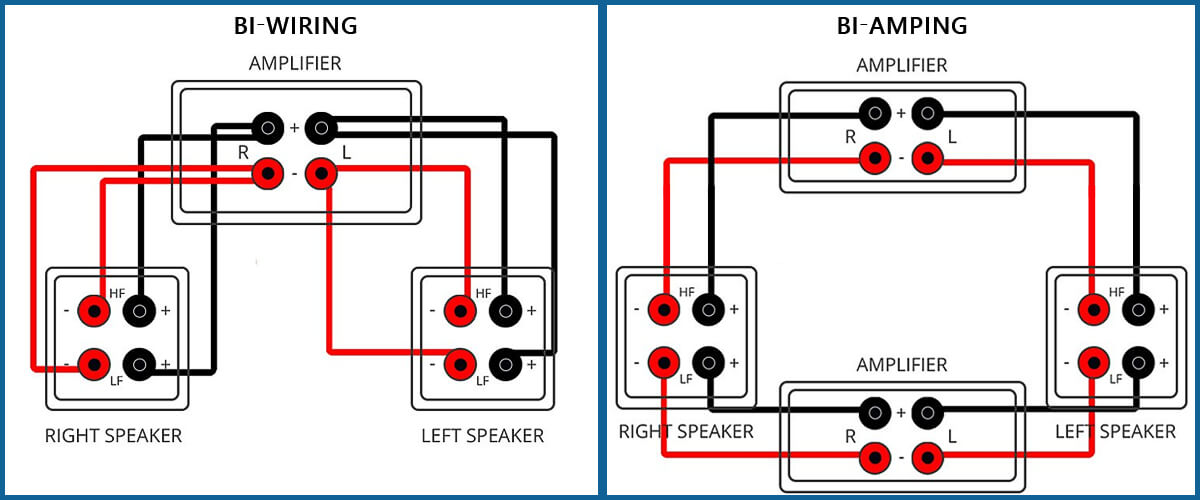Whether you are a music enthusiast, a movie buff, or a gamer, a high-quality AV receiver can bring your entertainment to life with crystal-clear sound and immersive effects. However, to truly unleash the full potential of your audio system, it’s crucial to understand the peculiarities of AV receiver speaker connections.
While some may see bi-wiring and bi-amping as optional extras, they can make a significant difference in sound. By optimizing the signal flow and reducing interference, these wiring techniques can provide a cleaner, more detailed sound with a wider soundstage and greater dynamic range. So, if you’re serious about achieving optimal sound quality from your audio system, it’s important to understand the benefits of bi-wiring and bi-amping. Today, I will explore the differences between the two techniques and offer some tips to help you make the most of your AV receiver.
Bi-wiring explained

Bi-wiring is a technique that involves using separate cables to connect the high-frequency and low-frequency drivers of a speaker to the AV receiver’s speaker connections. This means that instead of using a single cable for typical speaker connections, you use two cables to connect each speaker to the AV receiver. The idea behind bi-wiring is to reduce the interaction between the drivers, which can cause distortion and interfere with the sound quality.
The advantages of bi-wiring include:
Boosted sound quality
It can provide a more detailed and precise sound with a broader sound stage. By separating the high-frequency and low-frequency signals, this type of connection can reduce interference and improve the overall sound quality.
Extensive control
This wiring technique can allow for better control over the speakers and can help to prevent distortion at high volumes.
Disadvantages of bi-wiring include:
Price
This approach can be more expensive and time-consuming than traditional wiring methods. You will need to purchase separate cables for each speaker and ensure that the connections are secure and correctly configured.
Compatibility
Not all speakers are compatible with bi-wiring, so you must check the manufacturer’s specifications before attempting to bi-wire your speakers.
Bi-amping explained

Bi-amping is a technique that involves using separate power amplifiers to drive the high-frequency and low-frequency drivers of a speaker. This means that instead of using the AV receiver’s built-in amplifier to power the speakers, you use separate amplifiers to power each one. The idea behind bi-amping is to provide more power and control to the speakers and to reduce distortion and interference.
The advantages of bi-amping
Additional power
It can provide a more powerful, controlled sound with better clarity and detail. Using separate amplifiers, you can optimize the power distribution to the speakers and ensure that each driver receives the correct amount of power. Thus, it is very valuable when you work on optimizing AV receiver setup if it includes additional amplifiers.
Prevents distortions
Bi-amping can help to prevent distortion at high volumes and optimize AV receiver setup for optimal sound quality. I had never had problems with distortions when I used bi-amping with separate amplifiers.
Disadvantages of bi-amping
Price
It can be more expensive than traditional wiring methods, as you will have to purchase separate amplifiers for each speaker.
Compatibility
Sadly, not all speakers are compatible with bi-amping, so you will need to check the manufacturer’s specifications before attempting to bi-amp your speakers. Furthermore, compatible speakers can be a bit costly.
Comparing bi-wiring and bi-amping

When you are on the edge thinking of ways to make home theater system optimization, there are two main techniques to consider: bi-wiring and bi-amping. While both approaches involve using multiple wires to connect your speakers to your AV receiver, as you can see, there are some key differences between them. So, here I created a table for your convenience—it gives you a quick summary of the main differences between bi-wiring and bi-amping:
| Feature | Bi-Wiring | Bi-Amping |
|---|---|---|
| Definition | Using separate wires for high/low | Using separate amplifiers for high/low |
| Benefits | Better signal separation, reduced interference, potentially improved sound quality | More power and control, reduced distortion at high volumes, potentially improved sound quality |
| Drawbacks | More expensive, not all speakers compatible, minimal improvement in sound quality | More expensive, not all speakers compatible with bi-amping, may not provide significant improvement in sound quality |
Choosing the right method for your system
So, bi-amping vs bi-wiring, which method is better for your system? The answer depends on your specific needs and preferences. If you’re looking for better signal separation and potentially improved sound quality, then bi-wiring may be the way to go.
On the other hand, if you want more power and control over your speakers, then bi-amping may be the better choice. Yet, it requires you to invest in separate amplifiers.
Ultimately, I can conclude that it’s essential to consider the benefits and drawbacks of each method for your exact case, based on the compatibility of your speakers, before deciding between these two.
Essential tips for unlocking your AV receiver’s full potential

Choosing the right cables and connectors
Selecting the right cables and connectors is vital for achieving high-quality sound. I recommend paying the most attention to the length, gauge, and quality of materials when selecting cables and connectors to reduce resistance and provide a cleaner sound. Also, based on my experience, cables with high-quality insulation, rigid construction, and gold-plated connectors allow optimal signal transmission.
Proper speaker placement and calibration
Proper speaker placement and calibration are essential for optimal sound quality. Start by positioning your speakers at ear level and equidistant from your listening position, experimenting with different distances and angles to find the best sound. Next, use the built-in calibration tools in your AV receiver to fine-tune the audio settings for each speaker and ensure well-balanced sound across the sound stage.




![Best 2-Channel Receiver [Expert Reviews and Buying Guide]](https://hometheaterology.com/wp-content/uploads/2023/11/best-2-channel-receiver-stereo-300x150.jpg)












